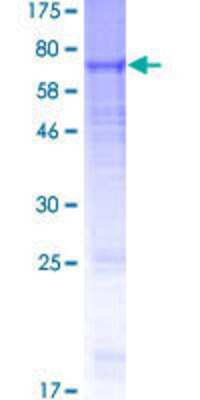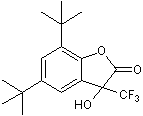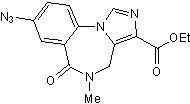GABA-A R beta 2 Products
GABA A (γ-aminobutyric acid-type A) receptors are members of the cysteine-loop family of neurotransmitter-gated ion channels. GABA binding to A-type receptors induces anion-selective ion channel opening. These receptors are the principal fast inhibitory neurotransmitter receptors in the CNS. GABA A receptors are heteropentamer combinations of seven subunit types; α, β, γ, δ, ε, θ, and π. Three subunits, α, β, and γ, have at least three separate gene products in mammals, and typical GABA A receptors have some combination of α, β, and γ subunits.
The rat β2 isoform is a 55 kDa, 450 amino acid (aa), 4 transmembrane protein with two terminal extracellular regions. The ligand-binding region is in the N-terminus (aa 13 - 218). The β2 subunit is part of the most common GABA A receptor combination in the mammalian brain (α1β2γ2). Like the other two beta subunits, beta 2 is phosphorylated on a consensus phosphorylation site (S410 of the precursor) that exists in the second cytoplasmic domain. In contrast to the other beta subunits, only PKC is capable of this modification. However, tyrosine phosphorylation of beta 2 is known, and this apparently increases GABA A current amplitude.
23 results for "GABA-A R beta 2" in Products
23 results for "GABA-A R beta 2" in Products
GABA-A R beta 2 Products
GABA A (γ-aminobutyric acid-type A) receptors are members of the cysteine-loop family of neurotransmitter-gated ion channels. GABA binding to A-type receptors induces anion-selective ion channel opening. These receptors are the principal fast inhibitory neurotransmitter receptors in the CNS. GABA A receptors are heteropentamer combinations of seven subunit types; α, β, γ, δ, ε, θ, and π. Three subunits, α, β, and γ, have at least three separate gene products in mammals, and typical GABA A receptors have some combination of α, β, and γ subunits.
The rat β2 isoform is a 55 kDa, 450 amino acid (aa), 4 transmembrane protein with two terminal extracellular regions. The ligand-binding region is in the N-terminus (aa 13 - 218). The β2 subunit is part of the most common GABA A receptor combination in the mammalian brain (α1β2γ2). Like the other two beta subunits, beta 2 is phosphorylated on a consensus phosphorylation site (S410 of the precursor) that exists in the second cytoplasmic domain. In contrast to the other beta subunits, only PKC is capable of this modification. However, tyrosine phosphorylation of beta 2 is known, and this apparently increases GABA A current amplitude.
| Reactivity: | Human, Mouse, Rat, Bovine, Canine, +1 More |
| Details: | Rabbit IgG Polyclonal |
| Applications: | WB |
| Reactivity: | Mouse, Rat |
| Details: | Rabbit IgG Polyclonal |
| Applications: | WB |
| Applications: | WB, ELISA, MA, AP |
| Reactivity: | Human |
| Details: | Rabbit Polyclonal |
| Applications: | WB |
| Reactivity: | Human |
| Details: | Rabbit Polyclonal |
| Applications: | WB |
| Reactivity: | Human |
| Details: | Rabbit Polyclonal |
| Applications: | WB |
| Applications: | WB |
| Applications: | WB |
Competitive and selective GABAA antagonist
| Alternate Names: | Gabazine |
| Chemical Name: | 6-Imino-3-(4-methoxyphenyl)-1(6H)-pyridazinebutanoic acid hydrobromide |
| Purity: | ≥98% (HPLC) |
Positive allosteric modulator of GABAA receptors
| Alternate Names: | 3a,5a-THPROG |
| Chemical Name: | (3α,5α)-3-Hydroxy-pregnan-20-one |
GABAA agonist
| Alternate Names: | Gaboxadol |
| Chemical Name: | 4,5,6,7-Tetrahydroisoxazolo[5,4-c]pyridin-3-ol hydrochloride |
| Purity: | ≥98% (HPLC) |
α5-selective GABAA inverse agonist
| Chemical Name: | 3-(1,1-Dimethylethyl)-7-(5-methyl-3-isoxazolyl)-2-[(1-methyl-1H-1,2,4-triazol-5-yl)methoxy]-pyrazolo[1,5-d][1,2,4]triazine |
| Purity: | ≥98% (HPLC) |
GABAA partial agonist; displays subtype selectivity
| Chemical Name: | 3-(2,5-Difluorophenyl)-7-(1,1-dimethylethyl)-6-[(1-methyl-1H-1,2,4-triazol-5-yl)methoxy]-1,2,4-triazolo[4,3-b]pyridazine |
| Purity: | ≥98% (HPLC) |
Postitive allosteric modulator of GABAA receptors
| Chemical Name: | (3α,5β)-3-Hydroxy-pregnan-20-one |
Benzodiazepine antagonist
| Alternate Names: | Ro 15-1788 |
| Chemical Name: | 8-Fluoro-5,6-dihydro-5-methyl-6-oxo-4H-imidazo[1,5-a][1,4]benzodiazepine-3-carboxylic acid, ethyl ester |
| Purity: | ≥99% (HPLC) |
Active metabolite of oxcarbazepine (Cat. No. 3864)
| Alternate Names: | GP 47779 |
| Chemical Name: | 10,11-Dihydro-10-hydroxy-5H-dibenz(Z)[b,f]azepin-5-carboxamide |
| Purity: | ≥98% (HPLC) |
Benzodiazepine partial agonist
| Alternate Names: | Ro 16-6028 |
| Chemical Name: | (13aS)-8-Bromo-11,12,13,13a-tetrahydro-9-oxo-9H-imidazo[1,5-a]pyrrolo[2,1-c][1,4]benzodiazepine-1-carboxylic acid 1,1-dimethylethyl ester |
| Purity: | ≥98% (HPLC) |
Benzodiazepine inverse agonist
| Chemical Name: | N-Methyl-β-carboline-3-carboxamide |
| Purity: | ≥99% (HPLC) |
Benzodiazepine inverse agonist
| Chemical Name: | 4-Ethyl-6,7-dimethoxy-9H-pyrido[3,4-b]indole-3-carboxylic acid methyl ester hydrochloride |
| Purity: | ≥98% (HPLC) |
Potent and selective postitive allosteric modulator of GABAB receptors
| Chemical Name: | 5,7-Bis(1,1-dimethylethyl)-3-hydroxy-3(trifluoromethyl)-2(3H)-benzofuranone |
| Purity: | ≥98% (HPLC) |
Benzodiazepine partial inverse agonist
| Chemical Name: | 8-Azido-5,6-dihydro-5-methyl-6-oxo-4H-imidazo[1,5-a][1,4]benzodiazepine-3-carboxylic acid ethyl ester |
| Purity: | ≥98% (HPLC) |



![Western Blot: GABA-A R beta 2 Antibody [NB300-198] Western Blot: GABA-A R beta 2 Antibody [NB300-198]](https://resources.bio-techne.com/images/products/GABA-A-R-beta-2-Antibody-Western-Blot-NB300-198-img0004.jpg)

![Western Blot: GABA-A R beta 2 Antibody [NBP2-88823] Western Blot: GABA-A R beta 2 Antibody [NBP2-88823]](https://resources.bio-techne.com/images/products/GABA-A-R-beta-2-Antibody-Western-Blot-NBP2-88823-img0001.jpg)
![Western Blot: GABA-A R beta 2 Antibody [NBP2-88824] Western Blot: GABA-A R beta 2 Antibody [NBP2-88824]](https://resources.bio-techne.com/images/products/GABA-A-R-beta-2-Antibody-Western-Blot-NBP2-88824-img0001.jpg)
![Western Blot: GABA-A R beta 2 Antibody [NBP2-88825] Western Blot: GABA-A R beta 2 Antibody [NBP2-88825]](https://resources.bio-techne.com/images/products/GABA-A-R-beta-2-Antibody-Western-Blot-NBP2-88825-img0001.jpg)
![Western Blot: GABA-A R beta 2 Overexpression Lysate [NBL1-10921] Western Blot: GABA-A R beta 2 Overexpression Lysate [NBL1-10921]](https://resources.bio-techne.com/images/products/GABA-A-Receptor-beta-2-Overexpression-Lysate-Adult-Normal-Western-Blot-NBL1-10921-img0002.jpg)
![Western Blot: GABA-A R beta 2 Overexpression Lysate [NBP2-11262] Western Blot: GABA-A R beta 2 Overexpression Lysate [NBP2-11262]](https://resources.bio-techne.com/images/products/GABA-A-Receptor-beta-2-Overexpression-Lysate-Adult-Normal-Western-Blot-NBP2-11262-img0001.jpg)













